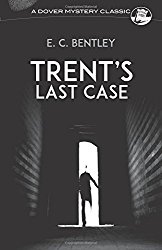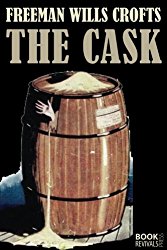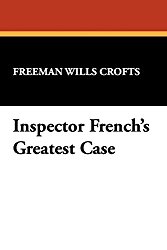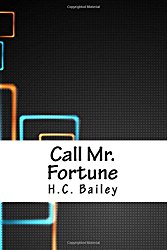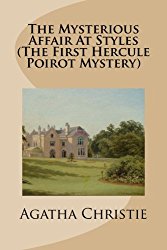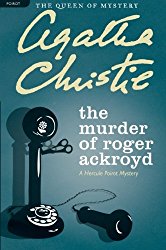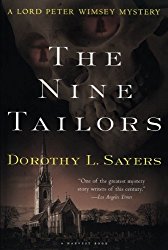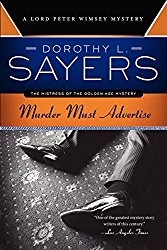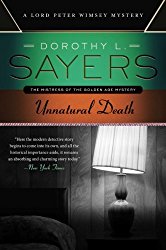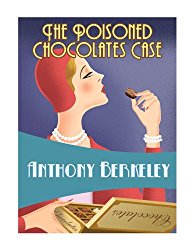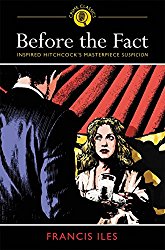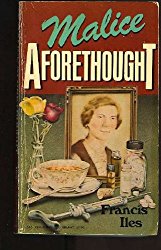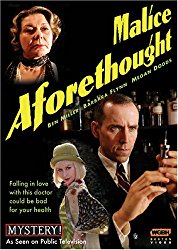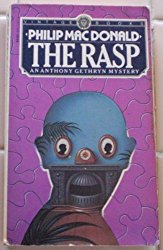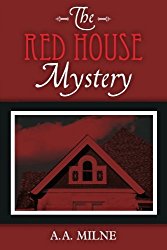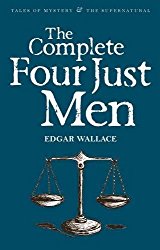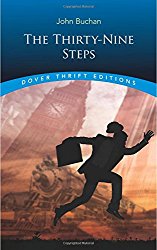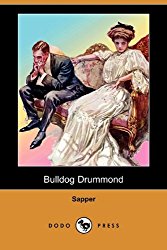The "Golden" Age: England: 1918-1930
E.C. Bentley (Edmund Clerihew Bentley) (July 10, 1875 to March 30, 1956) wrote Trent's Last Case (1913), which Howard Haycraft calls "one of the great cornerstones of the detective story." Years later, Bentley wrote in his autobiography, "It should be possible, I thought, to write a detective story in which the detective was recognizable as a human being and was not quite so much the 'heavy sleuth.'... Why not show up the fallibility of the Holmesian method?... In the result, it does not seem to have been generally noticed that Trent's Last Case is not so much a detective story as an exposure of detective stories" (Those Days, 1940)
|
Click Image to |
Bentley was reacting to the current vogue where amateur sleuths (in fiction) solved crimes that the police were unable to. His detective was Philip Trent, a journalist. Bentley had a lifelong friendship with G.K. Chesterton, whom he succeeded (after Chesterton's death) as president of the Detection club. John Buchan was also a friend. (More about Buchan later.) Other Philip Trent books didn't appear for more than twenty years after Trent's Last Case:
|
J.S. Fletcher (Joseph Smith Fletcher) (1863-1935) was "discovered" by Woodrow Wilson in 1918.
- The Middle Temple Murder (1918) is the book that pleased President Wilson. It still remains his topmost achievement, according to Haycraft, who said, "he never produced a really significant single detective character, with the possible exception of Roger Camberwell, the hero of a series of inferior adventures written in the author's last years, long after his best work was done" (Murder for Pleasure).
Changes in the detective story began to appear around this time, with a trend toward the police detective as hero.
Freeman Wills Crofts (1879- ) was the first to use step-by-step methods of actual police routine. He developed "almost mathematical detective plots." Readers and critics say he was never equaled, much less surpassed. (Note: These comments were made well before Evan Hunter/Ed McBain was writing.) Willard Huntington Wright wrote, "For sheer dexterity of plot Mr. Crofts has no peer among contemporary writers of detective fiction" (The Great Detective Stories).
|
Howard Haycraft calls The Cask (1920) a "masterpiece of practical crime detection." Raymond Chandler says that Freeman Wills Crofts is "the soundest builder of them all when he doesn't get too fancy" ("The Simple Art of Murder"). And James Sandoe points out that Freeman Wills Crofts took a "first step" from conventional detective story toward a psychological thriller with willful and premeditated murder ("The Dagger of the Mind"). |
Click Image to Click the image below to |
|
Click Image to Click the image below to |
Crofts developed the painstaking demolition of the "unbreakable" alibi. His Inspector French's Greatest Case (1924) introduces Inspector French. Haycraft calls it " a volume worthy in almost every way to find its place on the shelf beside The Cask" (Murder for Pleasure). |
E.M. Wrong says The Ponson Case includes "a Napoleon of crime and a Wellington of detection" but "...were the enemy the intellectual prodigy he is painted, he would begin operations by snuffing out the detective before the detective knew of his existence" ("Crime and Detection"). The motives were "robbery, forgery, blackmail, and murder" and the book carries on "the Moriarty theme."
Willard Huntington Wright writes that The Cask and The Ponson Case are "masterpieces of closely-wrought construction" and says that The Groote Park Murder, Inspector French's Greatest Case, and The Starvel Hollow Tragedy "stand as the foremost representatives of their kind -- as much as do the novels of Gaboriau and the Holmes series of Conan Doyle" (The Great Detective Stories).
Patrick Hamilton wrote Hangover Square; or The Man With Two Minds, a tale of a schizophrenic, told from his own shifting personalities.
James Sandoe writes "Hangover Square is far more genuinely a psychological thriller than a good many other novels which have been given the name and a good deal of admiring attention recently" ("The Dagger of the Mind").
One Man's Opinion
Raymond Chandler writes "The English may not always be the best writers in the world, but they are incomparably the best dull writers" ("The Simple Art of Murder").
|
Click Image to Click the image below to |
H.C. Bailey (Henry Christopher Bailey) (1878) created his detective Reggie Fortune, a doctor by profession and a detective by accident. Call Mr. Fortune (1920) Bailey also created Joshua Clunk, a "villainous detective" who has been described simultaneously as a "criminal lawyer" and a "lawyer criminal." Clunk appears in the novel Garstons (1930) (as The Garston Murder Case in America). |
The Female of the Species
"The first seventy-five or eighty years of the genre produced only a handful of craftwomen who can be mentioned beside their masculine confreres....it was left for the 1920's to see the development of really distinguished women writers within the full meaning of the act" (Howard Haycraft, Murder for Pleasure.)
Haycraft says "...at her frequent best Agatha Christie is easily one of the half-dozen most accomplished and entertaining writers in the modern field" and "...when he [Poirot] is at the top of his form few fictional sleuths can surpass the amazing little Belgian....few sleuths have been more rewarding than Poirot at the height of his powers..." (Murder for Pleasure).
|
Agatha Christie (September 15, 1890 to January 12, 1976) introduced Hercule Poirot in The Mysterious Affair at Styles (1920). Poirot Investigates, and Murder on the Links are all described as "Poirot at his best" by Willard Huntington Wright (The Great Detective Stories). |
Click Image to Click the image below to |
|
But The Murder of Roger Ackroyd (1926) really created a division in the world of connoisseurs. One camp cried "Foul" and "Unfair!" Another camp said, "You're supposed to suspect everyone! She was fair." Haycraft calls The Murder of Roger Ackroyd "...one of the true classics of the literature..." and "The best known and most widely discussed" of Christie's works." But Willard Huntington Wright says it is "hardly a legitimate device of the detective-story writer" (The Great Detective Stories). |
Click Image to Click the image below to |
Poirot's "Watson" is Captain Hastings. E.M. Wrong calls him "the most admirably foolish of all Watsons" (Crime and Detection).
Eden Phillpotts (male, November 1862 to December 29, 1960) wrote The Grey Room (1921) which, Willard Huntington Wright tells us, "immediately took its place among the leading mystery stories of the day" (The Great Detective Stories). The plot of The Grey Room centered on a haunted room in an English manor house. Philpotts also wrote a play calledThe Farmer's Wife, which Alfred Hitchcock made into a silent film. The Red Redmaynes (1922) was, according to Wright, "a more elaborately worked out detective novel" (The Great Detective Stories), and Jacques Barzun said it was "a classic detective novel that has never received due recognition."
"Harrington Hext" was a psudonym, probably belonging to Phillpotts. "Hext" books include:
- The Thing at Their Heels (1923)
- Who Killed Cock Robin (1924)
Inspector Ringrose (Phillpotts) and Inspector Midwinter ("Hext"). Both detectives are hard-working police investigators, but "closely woven plot rather than individual detective brilliance is his [Phillpotts's] forte..." (Howard Haycraft, Murder for Pleasure).
|
Dorothy Sayers (June 13, 1893 to December 17, 1957)is one of my personal all-time favorite writers, and I love to revisit Lord Peter Wimsey often. Haycraft calls her "...one of the most brilliant and prescient artists the genre has yet produced" (Murder for Pleasure) and wrote (in the 1940s) "...no writer to-day can surpass Miss Sayers either in suspense or mystification -- when she is of the mind."
|
Click Image to Click the image below to Click Image to Click the image below to |
Lord Peter Wimsey is Sayers's detective in all the books listed above. Haycraft says, "...only a few of all fiction's detectives have so brilliantly demonstrated their right to immortality as Lord Peter in his prime." She created another detective, named Montague Egg, who appeared in some short stories. Mr. Egg is a wine and spirit salesman extraordinary.
Sayers wrote only one non-Wimsey detective novel -- The Documents in the Case (1930)-- with "Robert Eustace." Haycraft says it is a superlative example of the medical detective story.
- Her
three anthologies are to be sought after. Each has a classic,
introductory essay, and each is divided into "Microcosmic" and
"Macrocosmic" stories. (Microcosmic stories have a down-to-earth
solution; Macrocosmic are supernatural tales.) Dorothy Sayers has said
that the most satisfying type of story are ones that seem to have a
supernatural element to them but in the end have a down-to-earth,
logical solution. I must confess that I, myself, find these most
satisfying. The Omnibus of Crime (English title: Great Short Stories of Detection, Mystery, and Horror), The Second Omnibus of Crime, The Third Omnibus of Crime
- With Gaudy Night (1935) "she definitely attempted to achieve a new form [of detective novel]" according to Haycraft (Murder for Pleasure). It is a murderless mystery.
- Busman's Honeymoon (1937) -- subtitled "a love story with detective interruptions" that tells the story of the Vane-Wimsey nuptials.
But although Howard Haycraft says, "She was the pioneer in the field," not everyone was impressed with her efforts. In The Saturday Review of Literature (1939), John Strachey wrote, "[Miss Sayers] has now almost ceased to be a first-rate detective writer and has become an exceedingly snobbish popular novelist.
|
Click Image to Click the image below to |
But Haycraft points out that her faults "...arise from her sincere and scholarly devotion to the detective story and represent a knowledgeable effort to improve it. They are honest and frankly experimental mistakes, not slovenly writing" (Murder for Pleasure). Her researches and "mistakes" led others to develop new directions for the detective story -- notably Francis Iles, Richard Hull, Anthony Rolls (psychological novel); Margery Allingham, Nicholas Blake, Michael Innes, Ngaio Marsh (the "literate school").
"...in the perfectly constructed detective story the questions Who? and How? are answered simultaneously at the denoument" (Howard Haycraft, Murder for Pleasure).
|
H. Douglas Thomson comments that one of Sayers's short stories, "Uncle Meleager's Will," is "merely a dramatized crossword puzzle."
G.D.H. and M.I. Cole -- George Douglas Howard Cole (b. 1889) and Margaret Isabel Postgate (b. 1893) were married in 1918. They wrote books together. The only story signed by G.D.H. Cole alone was The Brooklyn Murders (1923)(not Brooklyn, NY).
Cole created Superintendent Wilson, and Haycraft says the writing is "extremely uneven, including some of the best police adventures of the routine school, and some of the most tedious" (Murder for Pleasure).
Anthony Berkeley Cox
Anthony Berkeley Cox (July 5, 1893 to 1971), as Anthony Berkeley, wrote the Roger Sheringham novels ("good storytelling," says Haycraft). In Trial and Error(1937), Cox displays a remarkable knowledge of obscure legal procedure. Trial and Error has a "brilliant Trial-in-reverse." Cox also shows knowledge of journalism, diplomacy, and politics. Anthony Berkeley Cox said, "...Roger Sheringham is an offensive person, founded on an offensive person I once knew, because in my original innocence I thought it would be amusing to have an offensive detective. Since he has been taken in all seriousness, I have had to tone his offensiveness down and pretend he never was."
The Berkeley Credo: "...I am personally convinced [Berkeley wrote] that the days of the old crime-puzzle pure and simple, relying entirely upon plot and without any added attractions of character, style, or even humor, are in the hands of the auditor; and that the detective story is in the process of developing into the novel with a detective or crime interest, holding its readers less by mathematical than by psychological ties. The puzzle element will no doubt remain, but it will become a puzzle of character rather than a puzzle of time, place, motive, and opportunity" (quoted by Haycraft in Murder for Pleasure).
|
H. Doublas Thomson calls Sheringham "a less serious edition of Philip Trent."
|
Click Image to Click the image below to |
Francis Iles
|
Click Image to Click the image below to Click Image to Click the image below to The BBC Mystery television series dramatized Malice Aforethought. Highly recommended! (Click the image of the BBC series to order it from Amazon.) |
Haycraft indicated his belief that Francis Iles was a pseudonym of Anthony Berkeley Cox, and he was right. As Francis Iles, he has had a great influence on the orthodox detective story and has developed what became the "inverted" detective story. In the "inverted" story, the entire crime is shown first. You follow the criminal through the crime, often including his original plan, execution, and escape. Then (particularly as explicated by R. Austin Freeman's Dr. Thorndyke) the detective arrives on the scene and goes over the same territory that you, as a reader, have already been over. But now you observe the detective as he gathers and examines the clues.
|
Other names: Richard Hull, Anthony Rolls, and Peter Drax.
|
Click Image to Click the image below to |
Philip MacDonald, grandson of George MacDonald (author of many classic children's stories) wrote the Anthony Gethryn novels. The first Gethryn story is The Rasp (1924). Willard Huntington Wright calls The Rasp "Gethryn's sole vehicle of deduction." All of MacDonald's novels "are well above the average in readability and workmanship" and MacDonald "merits a distinguished place in a history of the modern detective story" (Howard Haycraft, Murder for Pleasure).
|
|
A.A. Milne (pp. 150, 151) (b. 1882- ) wrote his only bona fide detective story, The Red House Mystery (1922), which kept alive the naturalism of E.C. Bentley until Berkeley and MacDonald came (a year or two later). His detective, Antony Gillingham, anticipated humorous sleuths (both British and American). The Red House Mystery was the first novel "to go all out for what H. Douglas Thomson has described as the 'what fun!' type of crime fiction" (Howard Haycraft, Murder for Pleasure). Willard Huntington Wright says it is "...as well developed as it is well written" (The Great Detective Stories). |
Click Image to Click the image below to |
Alexander Woollcott calls The Red House Mystery "one of the three best mystery stories of all time" according to Raymond Chandler ("The Simple Art of Murder").
- The Perfect Alibi (1928) (also known as The Fourth Wall -- this seems to have been a play that Milne wrote that was made into a movie called The Perfect Alibi). Haycraft calls it an "ingenious affair in which the audience watched both the commission of the crime and the steps leading up to its detection" and says it deserves citations of honor (Murder for Pleasure).
|
Click Image to Click the image below to |
Edgar Wallace (1874-1932) (p. 151)( Richard Horatio Edward Wallace) was brought up as "Dick Freeman." In 27 years Wallace wrote or dictated 150 separate books. In 1928, "It was said the one out of every four books printed and sold in England, exclusive of Bibles, was an Edgar Wallace" and "Edgar Shanks has accurately called him 'a lost Dickens' " (Howard Haycraft, Murder for Pleasure).
|
Edgar Wallace's detective, J.G. Reeder, is "a sure-fire piece of popular character drawing; but his detective triumphs are likely to depend more upon chance than upon deduction...few but his [Wallace's] tales of J.G. Reeder qualify as bona-fide detection" (Haycraft, Murder for Pleasure).However, Wallace's influence in popularizing the detective story "was immense and immeasurable."
"John Rhode"(Major Cecil John Charles Street -- 1884 to 1964) was influential in the widening popularity of the detective story. Nicholas Blake has complained that he used "Ciphers in the place of characters."
- The Paddington Mystery (1925) is about his detective Dr. Priestly, a forensic scientist. (He also created investigator Desmond Merrion under the pseudonym Miles Burton.)
R.A.J. Walling (b. 1869- ) -- Robert Alfred John Walling wrote That Dinner at Bardolph's (1928), which was his first outstanding success in the field. In his later novels, his detective was Philip Tolefree.
Father Ronald Knox (b. 1888) (p. 156): "His stories ... are adroitly contrived and urbanely written, but many readers consider them intellectual exercises rather than fiction" (Howard Haycraft, Murder for Pleasure). Knox also presented a paper called "The Cult of Sherlock", which was responsible for launching interest in the study of Sherlock Holmes as a pseudo-intellectual pursuit.
Canon Victor L. Whitechurch (1868-1933) wrote "technically competent novels":
- Shot on the Downs (1927)
Frederick Harcourt Kitchin (1867-1932) (pseudonym "Bennet Copplestone") "is most widely and favorably known through a single short story 'The Butler,' taken from The Diversions of Dawson (1924), and found in numerous anthologies" (Howard Haycraft, Murder for Pleasure). Haycraft says, "Perhaps because of the high expectations aroused by this one tale, the remaining Dawson adventures are likely to seem clumsy and disappointing."
Allister McAllister (b. 1877) (pseudonym "Lynn Brock") created Colonel Gore (his detective).
Alfred Walter Stewart (b. 1880- )(his pseudonym "J.J. Connington") created his detectives Sir Clinton Driffield and The Counsellor. Dorothy Sayers makes the following two statements about J.J. Connington's Tragedy at Ravensthorpe "the falsely accused innocent need not be a sympathetic character" and "under the guise of fiction, actual murder cases drawn from real life" (The Omnibus of Crime).
Dorothy Feilding (yes, this is the correct spelling of her name. Her pseudonym is "A.E. Fielding" she's also listed as "A. Fielding"; her detective is Inspector Pointer). Willard Huntington Wright mentions the following three books
- The Footsteps that Stopped -- Wright says, "In The Footsteps that Stopped he has worked out an intricate problem along the painstaking lines of investigation characteristic of the actual methods of Scotland Yard" (The Great Detective Stories).
- The Eames-Erskine Case
- The Charteris Mystery
Charles Barry and his book The Detective's Holiday, is "...another good example of the plodding, naturalistic detective technic" (Willard Huntington Wright, The Great Detective Stories).
Lord Gorell (b. 1884 to 1963) made "a single excellent contribution," In the Night (1917).
Sir Henry Lancelot Aubrey-Fletcher, Bart. September 10, 1887 to May 30, 1969)(pseudonym "Henry Wade") created his detective (Inspector Poole):
- The Duke of York's Steps (1929)
- The Verdict of You All is a "first-rate story...." according to Gordeon Pleydell (quoted by Willard Huntington Wright, The Great Detective Stories).
A.W. Marchmont and Mark Allerton produced "two capable earlier examples of the detective novel of industrious routine..." (Willard Huntington Wright, The Great Detective Stories):
- A.W. Marchmont -- The Eargrave Square Mystery
- Mark Allerton -- The Mystery of Beaton Craig
Robert McNair Wilson (b. 1882- ) (pseudonym "Anthony Wynne") created the pseudo-psychological detective (in the field of "abnormal psychology"), Dr. Eustace Hailey. Wright says The Sign of Evil is his best.
Henry James Forman my be the first psychoanalytic detective. Wright says that Guilt is "a story which, despite its unconventional ending and its singularity of material, makes absorbing reading" (The Great Detective Story).
Will Scott (his detective is Disher) "has his share of followers among the connoisseurs" (Howard Haycraft, Murder for Pleasure).
Arthur John Rees (b. 1872- )(and his detective Colwin Grey) are "not so well known in America as they should be" (Howard Haycraft, Murder for Pleasure).
Forerunners of James Bond
|
John Buchan (Lord Tweedsmuir, 1875-1940) created Richard Hannay, his detective. The Thirty-Nine Steps (1915) was made into a classic movie by Alfred Hitchcock. |
Click Image to |
|
Click Image to Click the image below to |
H.C. McNeile (1888-1937) used the pseudonym "Sapper." In the military service, he wasn't allowed to publish under his real name, so he took as his pen name the colloquial term "Sapper," which is what engineers were called in the service. His character Bull-Dog Drummond was extremely popular through a series of books, plays, and movies. Buchan and McNeile/"Sapper" were "borderline between adventure and bona fide detection" (Howard Haycraft, Murder for Pleasure). Ian Fleming read both Buchan and McNeile, as well as books by Dornford Yates. |
John Leslie Palmer and Hilary Aiden St. George Saunders, under their pseudonym "Francis Beeding," created Colonel Granby (their detective). Haycraft refers to "the Beeding terror opera."
Lord Frederic Spencer Hamilton (1856-1928)created his detective, P.J. Davenant -- his detective.
Valentine Williams (b. 1883- ), who wrote "the Fox and Clubfoot tales," was "a topnotcher in his field" (Howard Haycraft, Murder for Pleasure).
C.J.W. Hosken (b. 1882- ) -- (Clifford James Wheeler Hosken), under the pseudonym "Richard Keverne," produced The Man in the Red Hat. sHoward Haycraft calls this "a particularly pleasing example" of his "numerous and entertaining narratives" (Murder for Pleasure).
Bertram Atkey wrote picaresque tales. His detective is Smiler Bunn.
Clemence Dane and Helen Simpson (1897-1940) wrote Enter Sir John (1928), a "marriage" of the detective story and the novel of character. This is a novel of theater life built around a murder mystery. Alfred Hitchcock made this into the classic film Murder (DVD). They followed this book up with Re-Enter Sir John (1932) -- "A sequel which, contrary to the usual rule in such matters, surpassed the original" (Haycraft, Murder for Pleasure).
To summarize the chief developments of the era, Howard Haycraft wrote, "In ending our consideration of the British detective story for this prolific period -- the richest single age in the literature -- it may be well to summarize briefly the chief developments of the era. They were three in number: (1) the vast improvement in the 'literacy' of the detective story; (2) the new insistence on fidelity and plausibility, as opposed to the old school of melodrama and hokum; and (3) the increased emphasis, particularly toward the end of the period, on character, with the concurrent wane of the story of mechanical plot alone. In all truth, it was 'The Golden Age' " (Murder for Pleasure, p. 158).
Amazon and the Amazon logo are trademarks of Amazon.com, Inc. or its affiliates.
(This is a link through which I make a small commission if you buy. See here for more details.)
